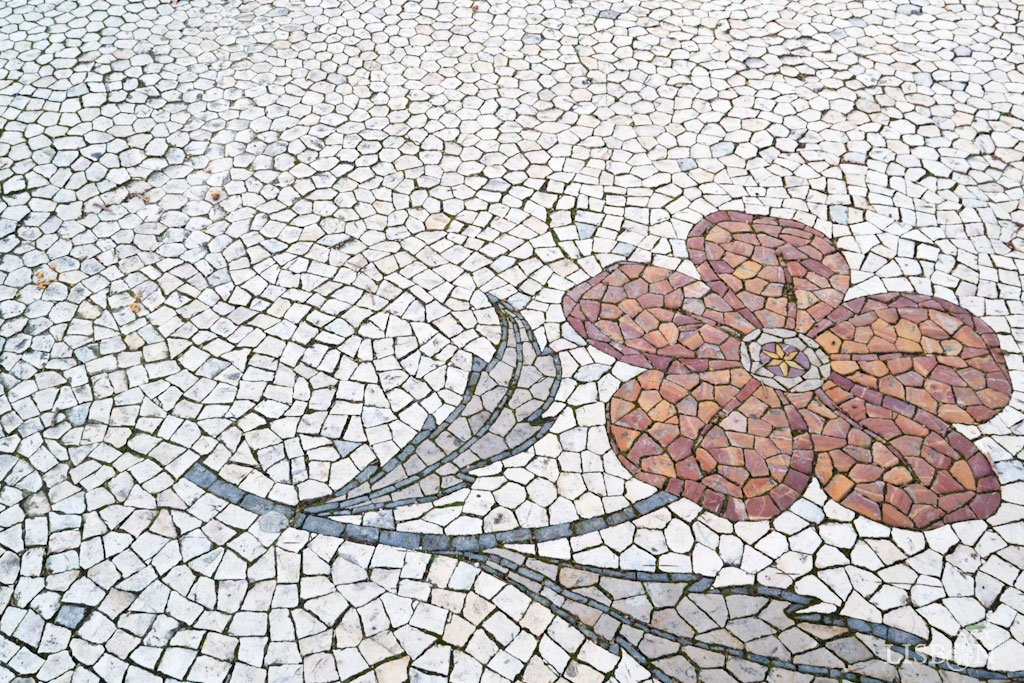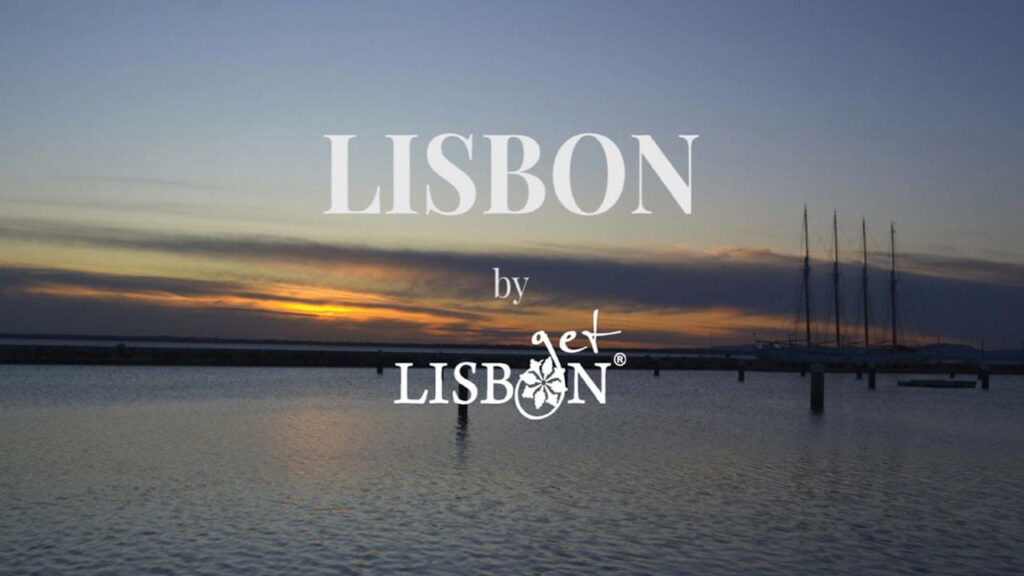| Never miss another article | Subscribe here |
The colours of the Portuguese pavement are determined by the stones used in its compositions, which are mostly black and white. There are also coloured Portuguese pavements, but they’re comparatively fewer in Lisbon. Let’s take a look at some of them. There’s one of them that deserves a closer look…
The Black and White
In The Origins of the Portuguese Pavement and Its First Exemplars we saw how this art was born in Lisbon, where the raw material for its production also came from – basalt and white limestone, both abundant in this region.
“For everything to be lisboeta in the art of paving, even the raw material has to be lisboeta (something or someone from Lisbon). The limestone comes from Monsanto, from the old quarries of Sabido, Campolide, or Fonte Santa. There’s also good limestone in Odivelas and Paço de Arcos. The basalt comes almost exclusively from Monsanto, but there is also some in Odivelas. In some rare cases, basalt has been replaced by the black limestone of Mem Martins.”, in Revista Municipal de Lisboa, Nº2, 1939.
However, with the expansion of the capital, many of the quarries were deactivated or urbanised and thus, there was a need to resort to more distant locations for the material supply.
Later, basalt began to be replaced by black limestone, a rock that was easier to work with.
This fact changed the appearance of the Portuguese pavement. Because until then the black of the basalt provided a more intense contrast with the white than the black limestone, which has different gradations of grey, as can be seen in the most recent Portuguese pavement compositions.
The difference in tone between these two types of rock can be easily identified when limestone is used to repair the old basalt pavements that still exist, such as in Duque da Terceira Square, in Cais do Sodré.

When it comes to graphic design, the use of black and white varies. In the patterns of the first exemplars there was a balance between black and white, such as in the zigzag of the parade ground of São Jorge Castle, which no longer exists, and the Mar Largo of Rossio Square.
There are old and rarer cases of white design on a black background, such as the one of Cais do Sodré. But, the majority of the drawings are black on a white background, which largely contributes to the increase of bright surfaces in the city that reflect not only the light but also the colours of the façades and roofs of the buildings, one of the important factors that enables the fascinating magic of Lisbon’s light.

However, there are surprising cases with the use of limestone in different shades of grey, red, yellow, orange… that can be seen in streets and squares.


The Colours of the Portuguese Pavement in Rua Lopes de Mendonça

Among the polychromatic examples that exist in Lisbon, the one in Rua Lopes de Mendonça, in Alvalade, is the most colourful and unique.
Along the approximately 100m sidewalk of São João de Brito School, we have a composition that includes a wide range of colours: black, grey, yellow, orange, red… on a white background.
This work, which reminds us of embroidery, is made up of a border of black ivy interrupted by tulips and sunflowers that surround butterflies and flowers that resemble pelargonium.
If at the first glance we’re attracted by the colours of the Portuguese pavement of this road, with a closer look we can see that it reveals enormous dedication, creativity, a taste for the art of paving and the mastery of stone breaking techniques by the paver artisans. Let’s see the details.
Tulips

The use of different colours or tones and the small black or grey pieces mark the inner and outer faces of the petals of the 12 existing tulips. It’s also worth noting the extraordinary detail of the ends and edges of the rolled leaves.
Butterflies

The combinations of colours in the different parts of the body make the 14 butterflies that result from the same mould, all different from each other.
Pelargonium

The leaves of the 15 flowers (one of which is incomplete) feature an outline made in small dark grey cobblestones that are filled with stones of a lighter tone. Each of the petals has a thin line in the middle that enriches the volume of the design. Amazingly, the geometric figures that form the eye of each of the flowers are unique.
Sunflowers

The yellow and pale grey impede the sunflowers from standing out from the light background, but the chess pattern in the eye of these flowers led us to observe them more closely.
Our great admiration for the technique and dedication in breaking the stones that make up each of these elements grew even more when, surprisingly, we noticed that two of the 15 sunflowers have a centre formed by small cylinders fitted into cubes with curved sides.
These details of pure technical virtuosity reproduce the design of the sunflowers and give them more dimension.

In fact, the richness of this set is not just the variety of colours, but also the difficult techniques of breaking stones, without which it would not be possible to execute all the details.
In addition to the malhete technique, which consists of applying stones of irregular shapes, of variable size and cut to fit perfectly, we can also observe the sextavado technique in which the stones are shaped in a hexagonal format. Today, only the latter technique is used in some artistic and decorative works.
We don’t know the date of this rare work. Photographs from the time and traces of some elements at the entrance of the school indicate that it was made after its construction in 1956.
The photo from the Lisbon Municipal Archive from 1968 shows us the sidewalk before the trees were planted, which sacrificed parts of it.

It’s also worth mentioning that there are components that were not replaced after works on the pavement, perhaps because of the technical requirements that this sidewalk needs. But the rarity of this authentic work of art, undoubtedly deserves its preservation and maintenance with the same care and dedication with which it was conceived.
Curious Fact:
In the renovated garden of Campo Mártires da Pátria, in the heart of Santana Hill, we can find, among other motifs, a bicolour pelargonium and butterfly and three black butterflies and two sunflowers identical to those of Rua Lopes de Mendonça. However, in this case the details defined by the chromatic variety aren’t present, nor the particularities of the eyes of the flowers.

The Colours of the Portuguese Pavement – Other Examples in Lisbon
In Lisbon there are other examples of polychromatic Portuguese pavement or pavement that present other colours than the traditional black and white.
- In the Belém area we have dozens of grey and yellow motifs around the fountain in the garden of Império Square. And in the square where the Planetarium and the Navy Museum are located, we can see a geometric pattern made in white, pink and two shades of grey;
- In the middle of Rua das Portas de Santo Antão, near the Coliseu dos Recreios, in downtown Lisbon, a Portuguese pavement composed of black and red stones alludes to the performing arts;
- In Cesário Verde Garden, in the Civil Parish of Arroios, there are several colourful decorative elements such as hearts of Viana, a guitar, a cat, a butterfly and plant-inspired motifs;
- In the centre of the churchyard of the Church of Our Lady of Light, in Carnide, the representation of a fountain is surrounded by a geometric pattern formed by black and red limestone;
- From the north of the city, in the Civil Parish of Olivais, we highlight two examples: one in Cidade do Luso Square and another in Rua Capitão-Tenente Oliveira e Carmo.
Many other pieces could be mentioned; look around for them and share with us! 😉
We also highlight two works outside the scope of pavements in which the colours of the Portuguese pavement are part of artistic pieces: the modernist panels by Maria Keil created for Cervejaria Trindade during its remodelling between 1945 and 1948, and the tribute to Amália located at Rua São Tomé in Alfama, made by Vhils in 2015.

The project getLISBON has been very rewarding and we want to continue revealing the singularities of fascinating Lisbon.
Help us keep this project alive!
By using these links to make your reservations you’ll be supporting us. With no extra costs!
• Looking for a different experience? We can create a customised itinerary based on your interests. Contact us!
• Or if you prefer tours and other activities in various destinations, take a look at GetYourGuide.
• Save time and money with a flexible Lisbon Card!




